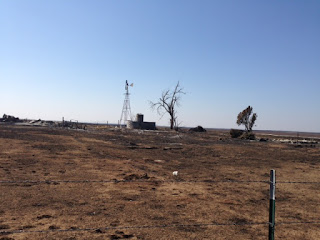The Heartland is a state of mind. It is land that sustains life. It is farmers that love the land. It is families that survive everything God and nature can throw at them. It is land that provides food and clothing for the world. It is farmers that through blood, sweat, and tears, get their crops or animals to market for our benefit. It is families that take care of their own and their neighbors. It is a place where firefighters, law enforcement, EMS, and volunteers give everything they have to protect life, limb, and property for people they don't even know, with little sleep, great humility, love and concern, often at great personal risk.
The Heartland is located wherever the farmers and ranchers live and work, and wherever people come together to overcome tragedy. The area may expand and contract, but the location is wherever the heart is. On 9/11, the Heartland was the entire United States. In 2005, it was the southern coast as Hurricane Katrina hit. In March 2017, the Heartland was Texas, Oklahoma, Kansas, Colorado and every state that sent aid to the wildfire affected areas.
This past few weeks, wildfires have destroyed millions of acres across the country. The destruction is massive and those affected are still reeling from the horror of having to destroy suffering, burned, livestock, seeing their homes lying in ashes on the ground. burying their dead children and husbands, losing everything in a few moments time and worrying how and if they can ever rebuild.
There was never any question of whether they would survive. I have witnessed the survival spirit in people I have talked to and stories I have read.
I have talked to firefighters whose "story" can be heard in their voices about the enormity of the job of fighting wildfires, especially these recent ones in Texas. They were bone tired during the first round of fires, moving from fire to fire, and then the second round hit along with working several accidents, at the same time.
One firefighter was burned over 30% of his body because the grader he was driving died, as the fire approached. He was saved by his father, running another grader behind him that saw him in trouble and pushed him out. He will be in the hospital for months recovering from his burns. He has a wife and children. Donate to James Moya-Injured Firefighter
A fire chief I spoke with was telling me about a fundraiser they were putting on, not for their own department, but for a little town's department that had depleted their resources fighting one of the big fires near them.



 At one of the supply centers, there were five semi-trucks that came in one right after the other in a 30 minute window, loaded with hay. All of those were from Texas, but I have talked to a trucker from Minnesota looking for a place to go with loads of hay, several ranchers here in Texas looking for trucks to take their hay to where it was needed. I have spoken with a young lady that rounded up several gooseneck loads of hay, fencing supplies, water, and clothes and lead two convoys to West Texas ranchers. I talked to AgriLife representatives that were instrumental in organizing a massive network of supply centers to receive all of the ranching and farming supplies that were headed their way. Their stories were encouraging and about getting the supplies moved to the needy ranchers after they got them in.
At one of the supply centers, there were five semi-trucks that came in one right after the other in a 30 minute window, loaded with hay. All of those were from Texas, but I have talked to a trucker from Minnesota looking for a place to go with loads of hay, several ranchers here in Texas looking for trucks to take their hay to where it was needed. I have spoken with a young lady that rounded up several gooseneck loads of hay, fencing supplies, water, and clothes and lead two convoys to West Texas ranchers. I talked to AgriLife representatives that were instrumental in organizing a massive network of supply centers to receive all of the ranching and farming supplies that were headed their way. Their stories were encouraging and about getting the supplies moved to the needy ranchers after they got them in.
On Facebook I read stories everyday of the same thing happening in Oklahoma and Kansas. Supplies are still coming in. People are still doing fundraisers. Volunteers are still working supply centers, even though some have shut down, at least temporarily. Volunteers are not only driving trucks and donating supplies, they are going on site to build fence, doctor livestock, staff food kitchens, deliver supplies from supply centers directly to ranchers and help clean up. Most of the firefighters are volunteers who have taken off work to battle the blazes.
As we watch the Heartland slowly heal, let us not forget that it is not over for them. They are getting back on their feet and figuring out where they stand, how much they have lost and what is needed to move forward. As they take that step towards their future, let us pray for the continued survival of this Heartland, for we never know when it might be us.
The pics are from our visit to Wheeler to take hay. There were two volunteers unloading hay and supplies in his pipe yard for Wheeler County ranchers shortly after the fires. They had been up 24 hours unloading hay there, giving the other location volunteers much needed rest. Five trucks were there at the same time and they said the day before it was almost nonstop.
2017 Panhandle Fire Relief Facebook Page Go here for information to bring supplies into the fire areas, donation information, to request supplies from supply centers, pictures and stories




